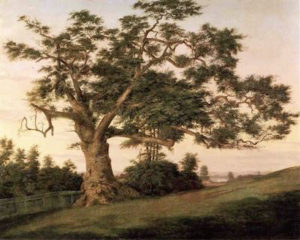
The Charter Oak
The great white oak was easily the tallest tree in the forest. It was over five hundred years old when the first white man laid eyes upon it in 1614, as he stood on the deck of a wooden ship anchored in the Connecticut River. Indeed, the Indians had for generations held their councils under its expansive boughs; the oak marked a place of great importance to them.
The oak’s location was in the area now known as Hartford. In 1639, the great Indian sachem Sequassen deeded the land west of the Connecticut River to the first white settlers; the parcel containing the enormous white oak then became the property of Samuel Wyllys. As he began to clear the forest, so that he might thereupon grow crops, Wyllys was visited by a delegation of Indians. They were fearful that their sacred tree might be destroyed along with the rest. They begged Wyllys to spare the tree, and eventually they prevailed–their holy place was saved from the axe.
In 1662, Connecticut received its Royal Charter from England’s King Charles II. This important document empowered the settlers with a legal basis, and gave the colony its autonomy with the king’s approval. As a result, Connecticut became an independent colony with its own government.
In 1687, King James II decided that the Connecticut officials should surrender the charter so that he could unite all of the New England colonies. The stiff-necked Connecticut settlers, ever an independent lot, immediately refused. So that he might force the issue, the king sent Sir Edmund Andros, governor of Massachusetts and Rhode Island to take control of the situation and retrieve the charter.
Andros knew that without possession of the charter, he would have little hope of gaining a political hold on Connecticut, and he was right. Andros met with the colonial leaders for a showdown at Butler’s Tavern in Hartford. The British sat in a cluster at one end of a long table; the colonists sat at the other end. Between them, the room was illuminated by two seven-candle candelabra. Threats were made by Andros, and ultimately, the charter was brought forth and laid upon the long table.
Suddenly—and there are conflicting accounts as to how this happened—the candelabra were knocked to the floor, and the room was cast into darkness. The charter was seized by unseen hands, and passed out a window to Captain Joseph Wadsworth, who was waiting there for it. He ran down Main Street, coattails flying, clutching the charter, and then hid it in a hollow in the trunk of the great white oak; there it remained until the British had ceased searching for it.
The colonists had won, the British had lost. And at the time of the American Revolution, of all the thirteen colonies there was but one independent, self-ruling colony, and that was our very own Connecticut.
Alas, the Charter Oak fell in a storm in 1856. However, its acorns were collected, and its offspring were planted all around Connecticut—including, according to local lore, one on West Haven Green “near the statue of the Doughboy,” in 1936.